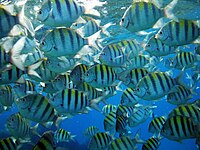|
Sergeant major (fish)
The sergeant major or píntano (Abudefduf saxatilis) is a species of damselfish. It grows to a maximum length of about 22.9 centimetres (9.016 in).[2] Distribution and habitatAbudefduf saxatilis is found in the Atlantic Ocean.[2] Populations in the western part of the Atlantic Ocean are found from the north eastern coast of the United States south to the Gulf of Mexico, the Bahamas, islands around the Caribbean Sea, the eastern coast of Central and South America all the way to Uruguay.[2] In the eastern Atlantic Ocean, they are found from Portugal, Azores, the Canary Islands, Cape Verde, and western Africa.[2] Its distribution remains unclear in the Mediterranean Sea due to possible confusion with Abudefduf vaigiensis and Abudefduf troschelii.[3] Juveniles are common in tide pools while adults are found over coral reefs.[2] Sergeant majors are found at depths of 0 to 40 metres (0 to 131 ft).[2] DescriptionAdults can grow up to 22.9 centimetres (9.0 in) at maximum length.[2] Normally, they would grow up to 15 centimetres (5.9 in).[2] The largest recorded specimen weighed had a weight of up to 200 grams (7.1 oz).[2] Abudefduf saxatilis has 13 dorsal spines, 12 to 13 dorsal soft rays, 2 anal spines, and 10 to 12 anal soft rays.[2] This fish is white with a yellow top. It has 5 black or dark blue vertical stripes. A faint sixth stripe might be present on the caudal peduncle.[2] Adult males have a more bluish coloration and its stripes are less visible.[2] There is a dark spot around its pectoral fin. Ecology DietThis fish feeds upon the larvae of invertebrates, zooplankton (such as copepods and shrimp larvae), pelagic tunicates, smaller fish, crustaceans, and various species of algae (both benthic and pelagic).[2][4] It is also known to feed on the waste and vomit of spinner dolphins.[2] BehaviorIndividuals of this species form shoals of about several hundred individuals.[2] Sometimes, they get cleaned of parasites by fish species such as gobies in the genus Gobiosoma, Bodianus rufus, Elacatinus figaro, and Thalassoma noronhanum.[2] Sergeant majors also clean green sea turtles along with Acanthurus chirurgus and Acanthurus coeruleus.[2] PredatorsPredators of this fish include Plectropomus leopardus, Thalassoma bifasciatum, Cephalopholis cruentata, Epinephelus striatus, Mycteroperca venenosa, and Rachycentron canadum.[2] In the aquariumThey are found in the aquarium trade but are regarded as difficult to breed.[5]  ReproductionThe sergeant major is an oviparous species in which the males create nests on rocks, reef outcrops, shipwrecks, and pilings where the females lay their egg masses.[6] The males actively chase the females in courtship before the female releases approximately 200,000 ref, ovoid eggs which are attached to the substrate by a filament; the eggs turn greenish after a few days and are guarded by the male. As he guards the eggs the male becomes bluish in colour, guarding them for about a week.[7] EtymologySergeant majors earn their name from their brightly striped sides, known as bars, which are reminiscent of the insignia of a military sergeant major.[7] References
External linksWikimedia Commons has media related to Sergeant major. Wikispecies has information related to Abudefduf saxatilis.
|
||||||||||||||||||||||||||||||||||||
